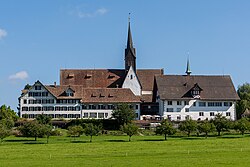Kappel Monastery
| Kappel Monastery | |
|---|---|
 Kappel Monastery today |
|
| location |
|
| Coordinates: | 47 ° 13 '38.2 " N , 8 ° 31' 28.7" E |
| Serial number according to Janauschek |
472 |
| founding year | 1185 |
| Year of dissolution / annulment |
1527 |
| Mother monastery | Hauterive Monastery |
| Primary Abbey | Clairvaux Monastery |

The Kappel Monastery is a former Cistercian monastery in Kappel am Albis in Switzerland .
history
From the foundation to the beginning of the 16th century
In 1185 the monastery was donated by the barons of Eschenbach - Schnabelburg and confirmed by Bishop Hermann II of Constance . A chapel was available to the first abbot Wilhelm and his monks to build a Cistercian monastery. The mother monastery of Kappel was Altenryf Abbey ( Canton of Friborg ). By Pope Innocent III. In 1211 the monastery received the Privilegium commune Cisterciense and it was placed under the protection of the Pope.
Until the end of the 14th century, the monastery received donations from the founding family and other noble families, especially in the Knonauer Amt , in Zugerland , today's Aargau , in the canton of Lucerne , on Lake Zurich and in the Zurich Unterland . In addition, there were isolated lands in central Switzerland. The monastery got into financial difficulties due to the social development, especially the emerging money economy , the upswing of the cities and the competition of the mendicant orders . In addition, the monastery came more and more under the influence of secular lords, especially after the assassination of King Albrecht in 1308. In 1344, the monastery concluded an eternal alliance with the city of Zug in 1344 and a similar one with Zurich in 1403. The monastery came through these alliances between the fronts in the Old Zurich War and was looted by the Confederates in 1443. On January 15, 1493, a fire devastated the convent building, which the abbot Ulrich at the time had rebuilt. Due to his dissolute lifestyle, Abbot Ulrich was forced to resign in 1508.
The Reformation
A new spirit arrived under Abbot Ulrich's successor, Wolfgang Joner . In 1523 he called Heinrich Bullinger , who was only nineteen, to Kappel, where he taught the monks and young men from the area as a private tutor. Through Bullinger, the teachings of the Reformation found their way to Kappel, and so on March 9, 1525 the pictures were removed from the monastery church and on September 4 of the same year the Holy Mass was abolished. A year later, on March 29, 1526, the monks celebrated the Lord's Supper for the first time according to the Reformed order and took off their robes. Many left the monastery and turned to a trade or became preachers . The convent finally handed the monastery over to the city of Zurich in 1527. Wolfgang Joner, Heinrich Bullinger and four other men stayed in Kappel and continued to run the school as a boarding school for boys. The previous monastery church became the parish church of Kappel. During the first Kappel War in 1529, Kappel became the scene of the march of the Reformed and Catholic troops in June, which came to a peaceful end with the legendary Kappel milk soup ; different on October 11, 1531, when the Zurich reformer Zwingli was killed in the second battle near Kappel .
The monastery today
After the Reformation, the monastery remained in Zurich's state domain. From 1834 the buildings were used for social purposes, and since 1983 by the Zurich regional church as a seminar hotel and educational center called the House of Silence and Encounter . Since 2008 it has been called Kloster Kappel again . The monastery has been renovated since 2009. The monastery church shows a glass painting work by the Swiss graphic artist and painter Max Hunziker in the choir .
The Kappel Monastery Association (formerly the Kappelerhof Association) is the owner of the Kappel Monastery domain (real estate, land, forest). The 14 association members are the 13 parishes of the Affoltern district and the Evangelical Reformed Church of the Canton of Zurich. The church and rectory belong to the Canton of Zurich.
literature
- Roland Böhmer: The former Cistercian monastery Kappel am Albis. (Swiss Art Guide GSK, Volume 728, Series 73). Ed. Society for Swiss Art History GSK. Bern 2002, ISBN 3-85782-728-9 .
- Thomas Huonker and Peter Niederhäuser: 800 years of Kappel Monastery - abbey, poor institution, educational center. Orell-Füssli, Zurich 2008, ISBN 3-280-06074-5 .
- Villmerger Wars : The entrenchments of the Kappel Monastery [1]
Web links
- Kappel Monastery
- Magdalen Bless-Grabher: Kappel (monastery). In: Historical Lexicon of Switzerland .
- Kappel Monastery Association: Site plan
